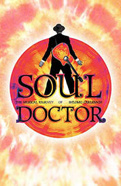Love, Prayer, LSD and Nina Simone: Get to Know Soul Doctor’s Rock Star Rabbi Shlomo Carlebach
Broadway is opening its arms to Rabbi Shlomo Carlebach, who changed the sound of Judaism in the 1960s with his guitar and original songs. In the new bio musical Soul Doctor, Eric Anderson takes audiences on a journey through Carlebach’s life, explaining how one man with a unique vision inspired people around the world. The musical is currently in previews at Circle in the Square Theatre, where it will officially open on August 15. Before joining in Soul Doctor’s celebration of music, love and peace, brush up on what made this man so memorable.
1. His Family Escaped Nazi Germany
Carlebach was born in Berlin in 1925. His father, Naftali, was an Orthodox rabbi descended from a long line of religious leaders. In 1933, the family fled from the Nazis, living first in Austria and Switzerland and then arriving in New York in 1939. Shlomo's father became the rabbi of a small synagogue on West 79th Street, Congregation Kehlilath Jacob.
2. He Called His Music a "Jewish Vitamin"
“When I became a Rav, I realized that most people don’t go to synagogues anymore," Carlebach said in the liner notes of his album HaNeshama Lach. "If your customers are not in the synagogues, you have to go out to them. But you just can’t talk to them, you have to sing to them. So I got myself a guitar and without even knowing whether I’d be able to reach anyone, I started singing.... My super specialty is that I make up my own songs. I take words of the prophets, and words from prayers which are about a better world, more peace in the world, more love in the world, more oneness. My songs are not against anything, they are only ‘for’.... They give strength, like a Jewish vitamin pill.”
3. He Founded a House of Love and Prayer
In 1967, Carlebach and his followers founded the House of Love and Prayer in the Inner Richmond district of San Francisco. Carlebach reached out to “lost Jewish souls” through song, dance and communal gatherings, combining the Orthodox Jewish religion with the changing attitudes of the late 1960s. Those who gathered at the house were often referred to as “Hassidic Hippies.” The house remained open through 1977.
4. He Had Progressive Views About Women
Carlebach did not buy into the Orthodox belief that men and women should not touch in public; he encouraged hugging and kissing men and women alike. When asked if the House of Love and Prayer should have amehitzah, a barrier separating men and women required in Orthodox Judaism, Carlebach responded, “There are enough walls in this world between people. What we’re here to do is tear them down.”
5. He Formed an Unlikely Alliance with Nina Simone
According to several accounts, Carlebach met jazz singer Nina Simone in 1957 when she was working as a pianist and lounge singer in Atlantic City. This daughter of a Baptist minister was drawn to the unconventional rabbi and even recorded a song in Hebrew. (Click below to watch the clip.) Carlebach went on to perform with Bob Dylan, Joni Mitchell, Jerry Garcia and the Grateful Dead and released 25 albums.
6. His Songs Inspired People Behind the Iron Curtain
One of Carlebach's most famous songs, "Am Yisroel Chai (The People of Israel Live)," became an anthem for Jewish people living behind the Iron Curtain. In 1989, as Communism began to crumble throughout Eastern Europe, Carlebach performed in Poland. He ended his concert with “Leman Achai Vereai (For My Brothers and Friends),” a song used to introduce Pope John Paul II at a 1995 papal mass in New Jersey.
7. LSD Wasn’t His Thing, But He Tried It
While some of his followers experimented with psychedelic drugs (it was San Francisco in the late 60s after all!), Carlebach abstained. However, in a recorded conversation with author and drug enthusiast Timothy Leary, the rabbi said he did try LSD once: “It was gewalt, but it did not compare to learning Talmud.” Leary, on the other hand, said he enjoyed listening to Carlebach’s music while hallucinating on acid.
8. He Died at LaGuardia Airport
At age 69, Shlomo Carlebach died of heart failure at NYC's LaGuardia Airport on October 20, 1994. His body was flown to Israel for burial at Har HaMenuchot, the largest cemetery in Jerusalem. After his death, services were held in the three cities he called home, with nearly 7,000 people crowding his father's temple on West 79th Street.
9. Controversy Exploded After His Death
In 1998, four years after his death, Lilith Magazine, a publication for Jewish women, published an exposé “A Paradoxical Legacy: Rabbi Shlomo Carlebach's Shadow Side,” which alleged that Carlebach sexually assaulted dozens of women. Soul Doctor creator Daniel Wise didn’t include the allegations in the musical because “after over 100 interviews with credible individuals, and researching dozens of credible documents and published articles, there was nothing I could find to support such allegations.”
10. His Life’s Work Continues
Services of Carlebach Minyan (a prayer service in Carlebach’s style that uses melodies he composed) continue in Los Angeles, New York, San Francisco and Israel. In 2010, The Shlomo Carlebach Legacy Trust was founded in order to preserve, publish and distribute his legacy as a Jewish National Treasure. Now, Broadway audiences can experience Carlebach’s life and achievements through the bio musical Soul Doctor.
Soul Doctor, starring Eric Anderson as Shlomo Carlebach, opens August 15 at Circle in the Square Theatre.
